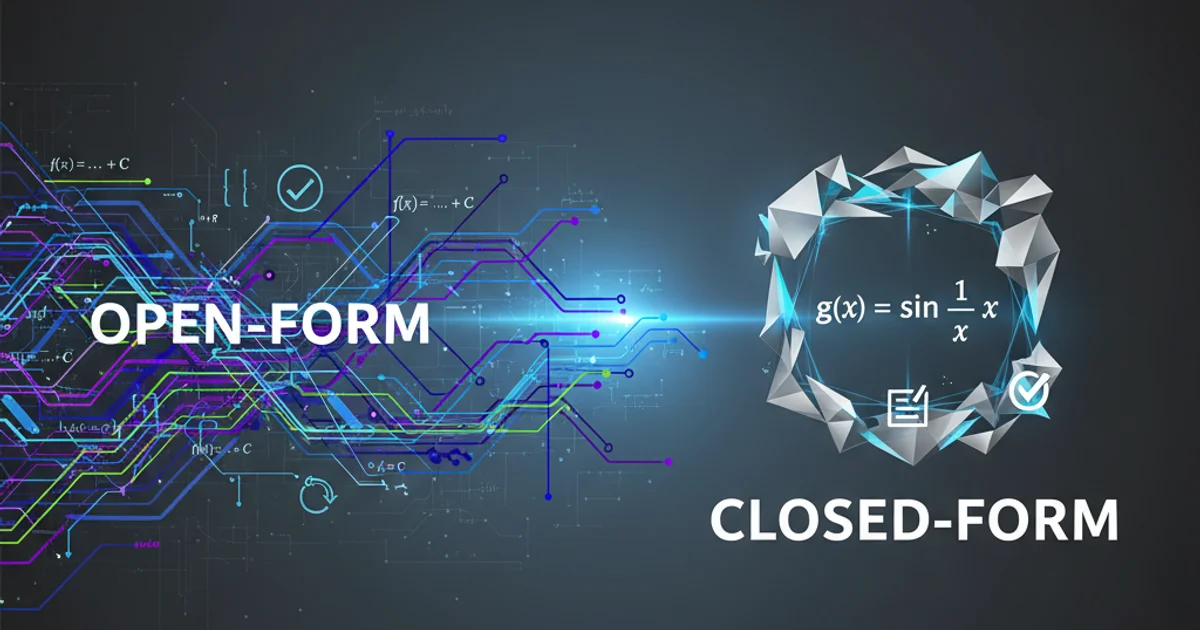Open-form and Closed form
Categories:
Understanding Open-Form and Closed-Form Solutions in Algorithms and Mathematics

Explore the fundamental differences between open-form and closed-form solutions, their implications in computational efficiency, and practical applications across various domains.
In the realms of mathematics, computer science, and engineering, the terms 'open-form' and 'closed-form' solutions frequently arise when discussing how problems are solved or functions are represented. These concepts are crucial for understanding the efficiency, elegance, and practical applicability of various algorithms and mathematical models. This article delves into what defines each type of solution, provides illustrative examples, and highlights their respective advantages and disadvantages.
What is a Closed-Form Solution?
A closed-form solution is an expression that can be evaluated in a finite number of standard operations. These operations typically include arithmetic operations (addition, subtraction, multiplication, division), exponentiation, logarithms, trigonometric functions, and their inverses. The key characteristic is that the solution does not involve an infinite series, limits, or iterative processes. When you have a closed-form solution, you can directly compute the result by plugging in the input values, often leading to very efficient computations.
import math
def quadratic_formula(a, b, c):
"""Calculates roots of a quadratic equation using the closed-form quadratic formula."""
discriminant = (b**2) - 4*(a*c)
if discriminant < 0:
return "No real roots"
elif discriminant == 0:
x = -b / (2*a)
return x
else:
x1 = (-b - math.sqrt(discriminant)) / (2*a)
x2 = (-b + math.sqrt(discriminant)) / (2*a)
return x1, x2
print(quadratic_formula(1, -3, 2)) # Output: (1.0, 2.0)
Python implementation of the quadratic formula, a classic closed-form solution.
What is an Open-Form Solution?
Conversely, an open-form solution (also known as an iterative, recursive, or series solution) cannot be expressed in a finite number of standard operations. These solutions often involve infinite series, limits, or require an iterative process to approximate the result to a desired level of precision. While closed-form solutions are preferred for their directness and efficiency, many real-world problems, especially in advanced mathematics and numerical analysis, only have open-form solutions. This doesn't make them less valid, but it does imply a different approach to computation, often involving numerical methods.
def factorial_recursive(n):
"""Calculates factorial using a recursive (open-form) definition."""
if n == 0 or n == 1:
return 1
else:
return n * factorial_recursive(n-1)
def pi_leibniz_series(iterations):
"""Approximates Pi using the Leibniz formula (an infinite series)."""
pi_approx = 0
for i in range(iterations):
term = 1 / (2 * i + 1)
if i % 2 == 0:
pi_approx += term
else:
pi_approx -= term
return 4 * pi_approx
print(factorial_recursive(5)) # Output: 120
print(pi_leibniz_series(10000)) # Output: 3.141492653591794
Examples of open-form solutions: a recursive factorial and an infinite series approximation for Pi.
Comparing Open-Form and Closed-Form Solutions
The choice between or recognition of these solution types has significant implications for algorithm design and computational performance. Closed-form solutions are generally faster and more precise, as they don't involve approximations or repeated calculations. Open-form solutions, while sometimes the only option, require careful consideration of convergence, computational cost, and error tolerance. Understanding this distinction helps in selecting appropriate algorithms and numerical methods for a given problem.
flowchart TD
A["Problem Statement"] --> B{"Is a direct, finite calculation possible?"}
B -- "Yes" --> C["Closed-Form Solution"]
C --> D["Direct Computation, High Precision, Fast"]
B -- "No" --> E["Open-Form Solution"]
E --> F["Iterative/Series Approximation, Convergence, Error Tolerance"]
D --> G["Optimal for many analytical problems"]
F --> G["Necessary for complex numerical problems"]
G["Solution Found"]Decision flow for identifying open-form vs. closed-form solutions.